automatic transmission DODGE DART 2015 PF / 1.G Owner's Guide
[x] Cancel search | Manufacturer: DODGE, Model Year: 2015, Model line: DART, Model: DODGE DART 2015 PF / 1.GPages: 664, PDF Size: 16.96 MB
Page 554 of 664
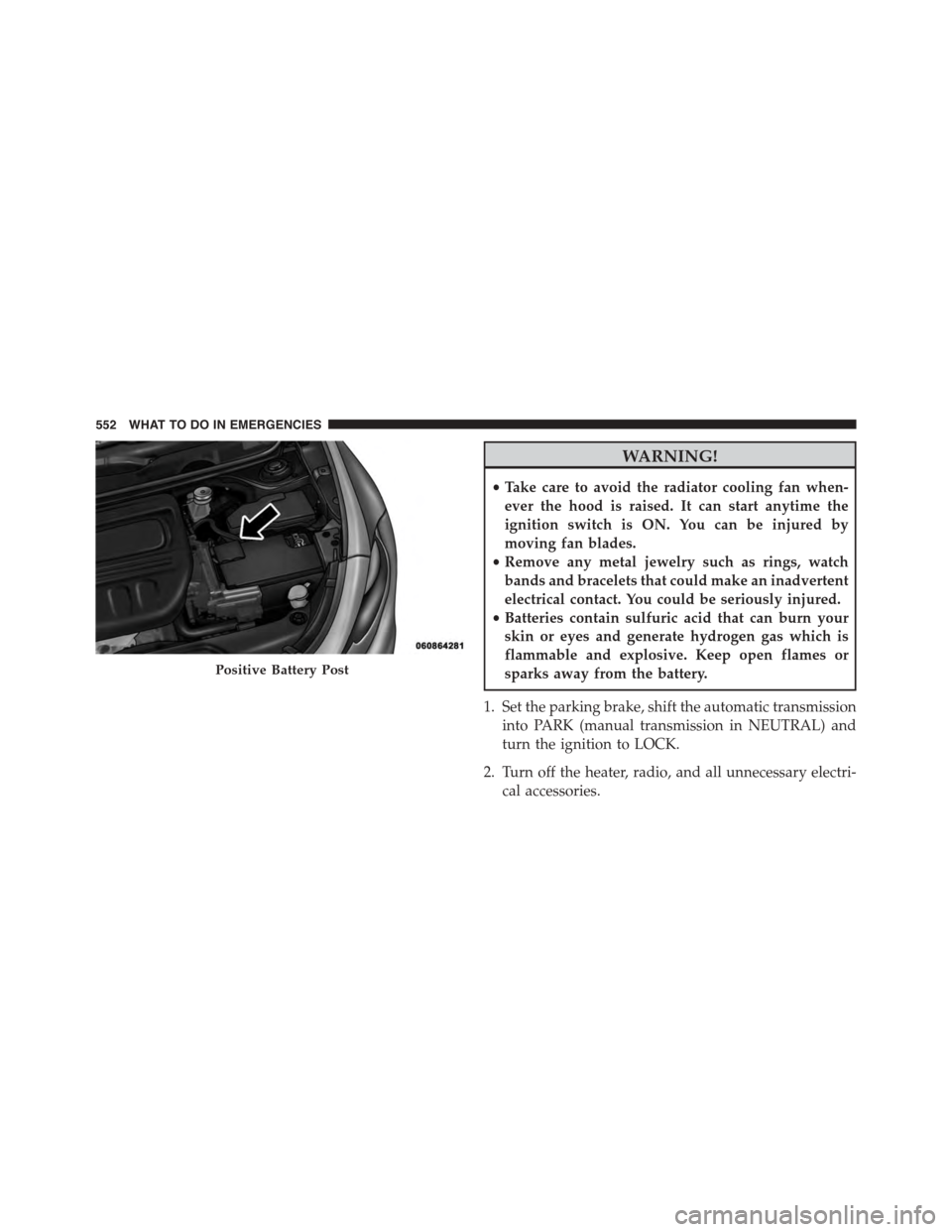
WARNING!
•Take care to avoid the radiator cooling fan when-
ever the hood is raised. It can start anytime the
ignition switch is ON. You can be injured by
moving fan blades.
•Remove any metal jewelry such as rings, watch
bands and bracelets that could make an inadvertent
electrical contact. You could be seriously injured.
•Batteries contain sulfuric acid that can burn your
skin or eyes and generate hydrogen gas which is
flammable and explosive. Keep open flames or
sparks away from the battery.
1. Set the parking brake, shift the automatic transmission
into PARK (manual transmission in NEUTRAL) and
turn the ignition to LOCK.
2. Turn off the heater, radio, and all unnecessary electri-
cal accessories.
Positive Battery Post
552 WHAT TO DO IN EMERGENCIES
Page 557 of 664
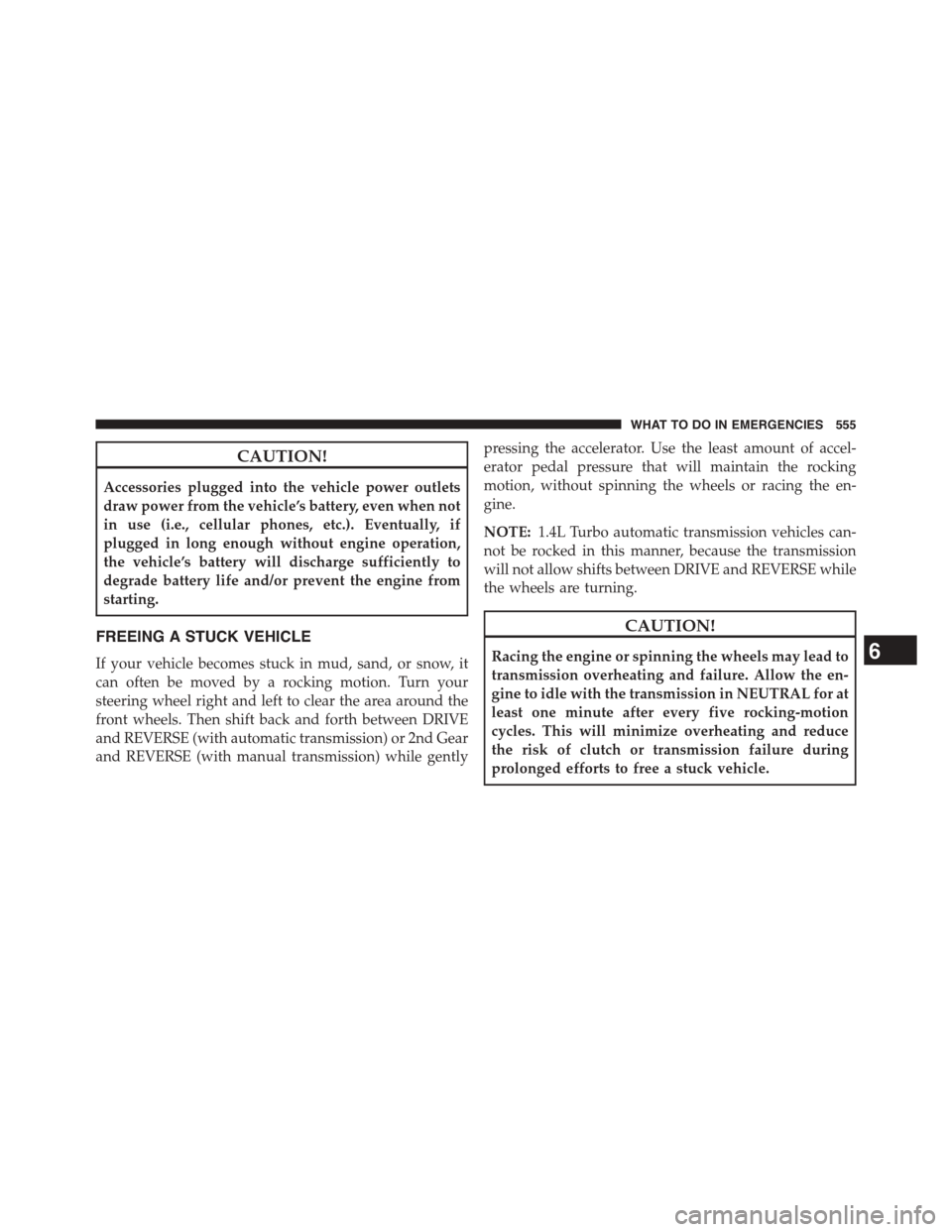
CAUTION!
Accessories plugged into the vehicle power outlets
draw power from the vehicle’s battery, even when not
in use (i.e., cellular phones, etc.). Eventually, if
plugged in long enough without engine operation,
the vehicle’s battery will discharge sufficiently to
degrade battery life and/or prevent the engine from
starting.
FREEING A STUCK VEHICLE
If your vehicle becomes stuck in mud, sand, or snow, it
can often be moved by a rocking motion. Turn your
steering wheel right and left to clear the area around the
front wheels. Then shift back and forth between DRIVE
and REVERSE (with automatic transmission) or 2nd Gear
and REVERSE (with manual transmission) while gently
pressing the accelerator. Use the least amount of accel-
erator pedal pressure that will maintain the rocking
motion, without spinning the wheels or racing the en-
gine.
NOTE:1.4L Turbo automatic transmission vehicles can-
not be rocked in this manner, because the transmission
will not allow shifts between DRIVE and REVERSE while
the wheels are turning.
CAUTION!
Racing the engine or spinning the wheels may lead to
transmission overheating and failure. Allow the en-
gine to idle with the transmission in NEUTRAL for at
least one minute after every five rocking-motion
cycles. This will minimize overheating and reduce
the risk of clutch or transmission failure during
prolonged efforts to free a stuck vehicle.
6
WHAT TO DO IN EMERGENCIES 555
Page 562 of 664
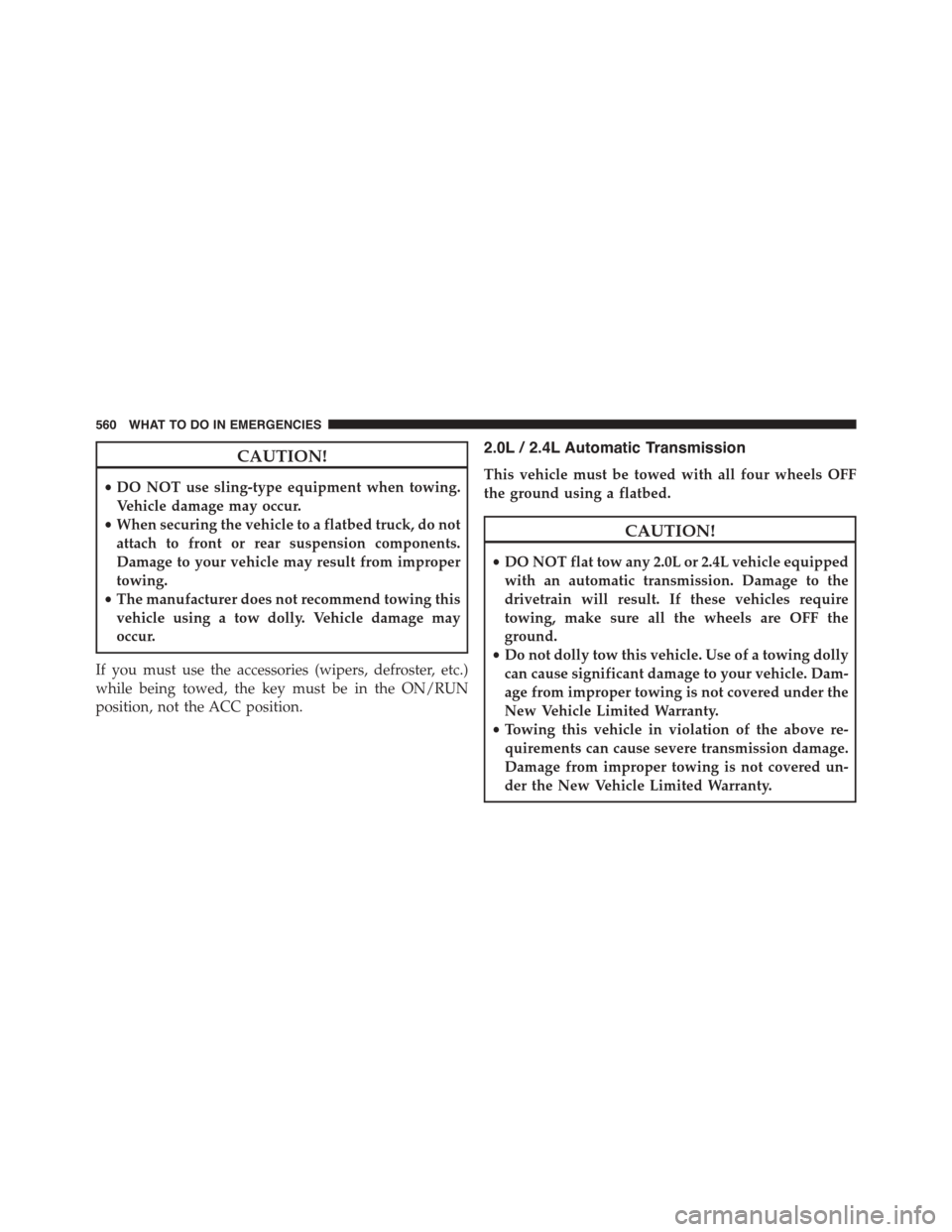
CAUTION!
•DO NOT use sling-type equipment when towing.
Vehicle damage may occur.
•When securing the vehicle to a flatbed truck, do not
attach to front or rear suspension components.
Damage to your vehicle may result from improper
towing.
•The manufacturer does not recommend towing this
vehicle using a tow dolly. Vehicle damage may
occur.
If you must use the accessories (wipers, defroster, etc.)
while being towed, the key must be in the ON/RUN
position, not the ACC position.
2.0L / 2.4L Automatic Transmission
This vehicle must be towed with all four wheels OFF
the ground using a flatbed.
CAUTION!
•DO NOT flat tow any 2.0L or 2.4L vehicle equipped
with an automatic transmission. Damage to the
drivetrain will result. If these vehicles require
towing, make sure all the wheels are OFF the
ground.
•Do not dolly tow this vehicle. Use of a towing dolly
can cause significant damage to your vehicle. Dam-
age from improper towing is not covered under the
New Vehicle Limited Warranty.
•Towing this vehicle in violation of the above re-
quirements can cause severe transmission damage.
Damage from improper towing is not covered un-
der the New Vehicle Limited Warranty.
560 WHAT TO DO IN EMERGENCIES
Page 563 of 664
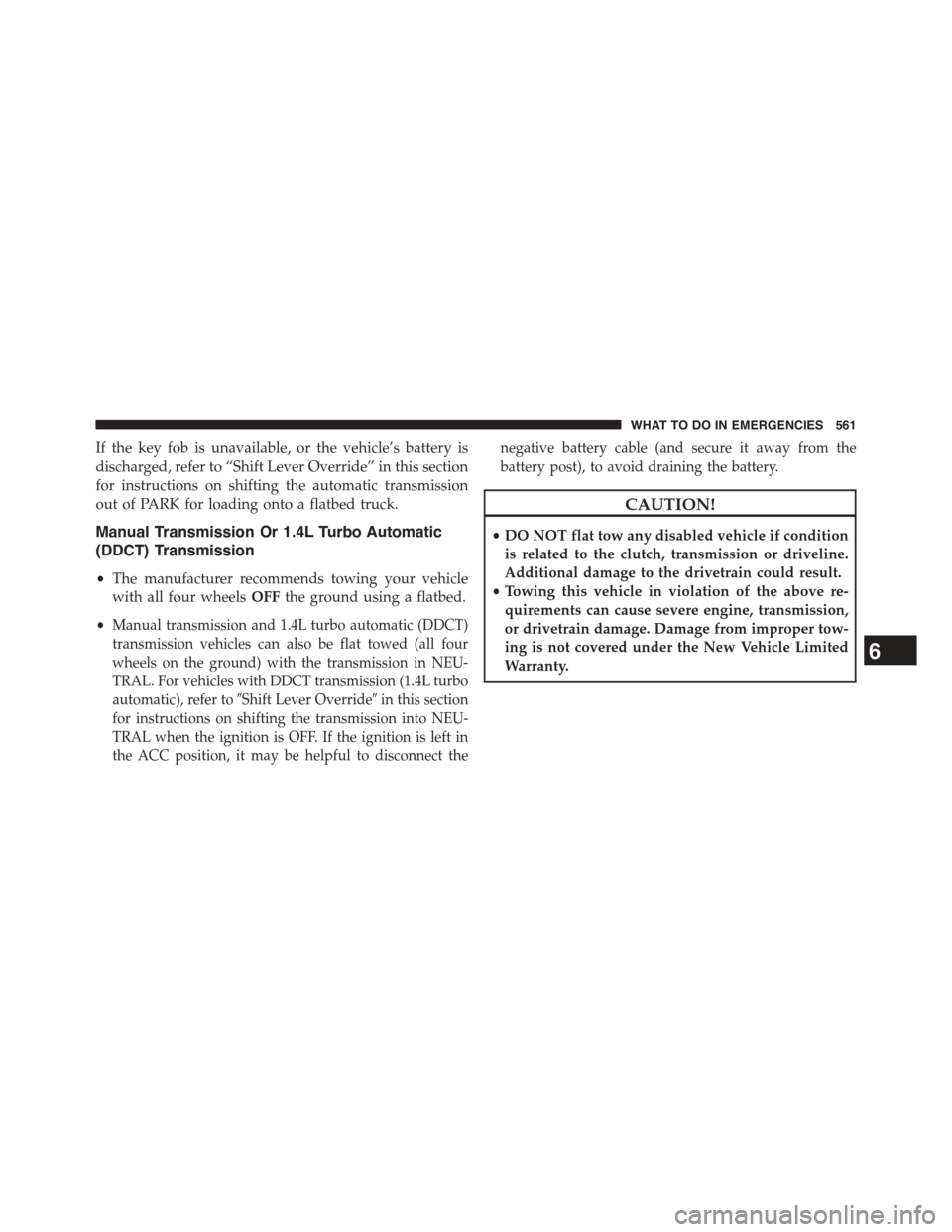
If the key fob is unavailable, or the vehicle’s battery is
discharged, refer to “Shift Lever Override” in this section
for instructions on shifting the automatic transmission
out of PARK for loading onto a flatbed truck.
Manual Transmission Or 1.4L Turbo Automatic
(DDCT) Transmission
•The manufacturer recommends towing your vehicle
with all four wheelsOFFthe ground using a flatbed.
•Manual transmission and 1.4L turbo automatic (DDCT)
transmission vehicles can also be flat towed (all four
wheels on the ground) with the transmission in NEU-
TRAL. For vehicles with DDCT transmission (1.4L turbo
automatic), refer to#Shift Lever Override#in this section
for instructions on shifting the transmission into NEU-
TRAL when the ignition is OFF. If the ignition is left in
the ACC position, it may be helpful to disconnect the
negative battery cable (and secure it away from the
battery post), to avoid draining the battery.
CAUTION!
•DO NOT flat tow any disabled vehicle if condition
is related to the clutch, transmission or driveline.
Additional damage to the drivetrain could result.
•Towing this vehicle in violation of the above re-
quirements can cause severe engine, transmission,
or drivetrain damage. Damage from improper tow-
ing is not covered under the New Vehicle Limited
Warranty.6
WHAT TO DO IN EMERGENCIES 561
Page 566 of 664

▫Exhaust System......................582
▫Cooling System......................585
▫Brake System........................591
▫Automatic Transmission — If Equipped.....593
▫Manual Transmission — If Equipped.......595
▫Appearance Care And Protection From
Corrosion...........................595
!FUSES..............................602
▫Interior Fuses........................602
▫Underhood Fuses......................604
▫Body Control Module (BCM) Fuses.........607
!VEHICLE STORAGE....................609
!REPLACEMENT BULBS.................609
!BULB REPLACEMENT..................611
▫Headlamps..........................611
▫Backup Lamps........................612
▫License Lamp........................613
!FLUID CAPACITIES....................615
!FLUIDS, LUBRICANTS AND GENUINE
PA R T S . . . . . . . . . . . . . . . . . . . . . . . . . . . . ..616
▫Engine.............................616
▫Chassis............................619
564 MAINTAINING YOUR VEHICLE
Page 570 of 664
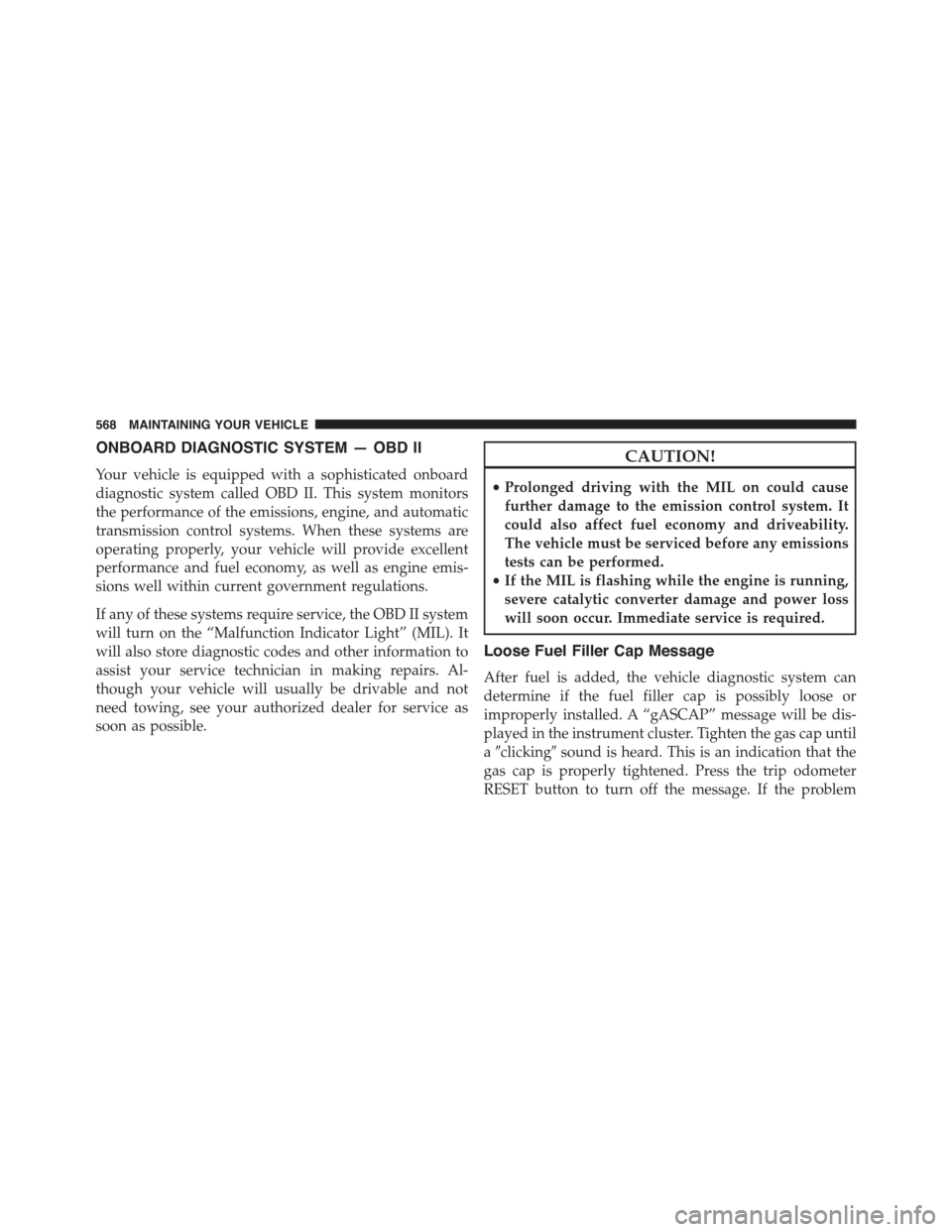
ONBOARD DIAGNOSTIC SYSTEM — OBD II
Your vehicle is equipped with a sophisticated onboard
diagnostic system called OBD II. This system monitors
the performance of the emissions, engine, and automatic
transmission control systems. When these systems are
operating properly, your vehicle will provide excellent
performance and fuel economy, as well as engine emis-
sions well within current government regulations.
If any of these systems require service, the OBD II system
will turn on the “Malfunction Indicator Light” (MIL). It
will also store diagnostic codes and other information to
assist your service technician in making repairs. Al-
though your vehicle will usually be drivable and not
need towing, see your authorized dealer for service as
soon as possible.
CAUTION!
•Prolonged driving with the MIL on could cause
further damage to the emission control system. It
could also affect fuel economy and driveability.
The vehicle must be serviced before any emissions
tests can be performed.
•If the MIL is flashing while the engine is running,
severe catalytic converter damage and power loss
will soon occur. Immediate service is required.
Loose Fuel Filler Cap Message
After fuel is added, the vehicle diagnostic system can
determine if the fuel filler cap is possibly loose or
improperly installed. A “gASCAP” message will be dis-
played in the instrument cluster. Tighten the gas cap until
a#clicking#sound is heard. This is an indication that the
gas cap is properly tightened. Press the trip odometer
RESET button to turn off the message. If the problem
568 MAINTAINING YOUR VEHICLE
Page 595 of 664
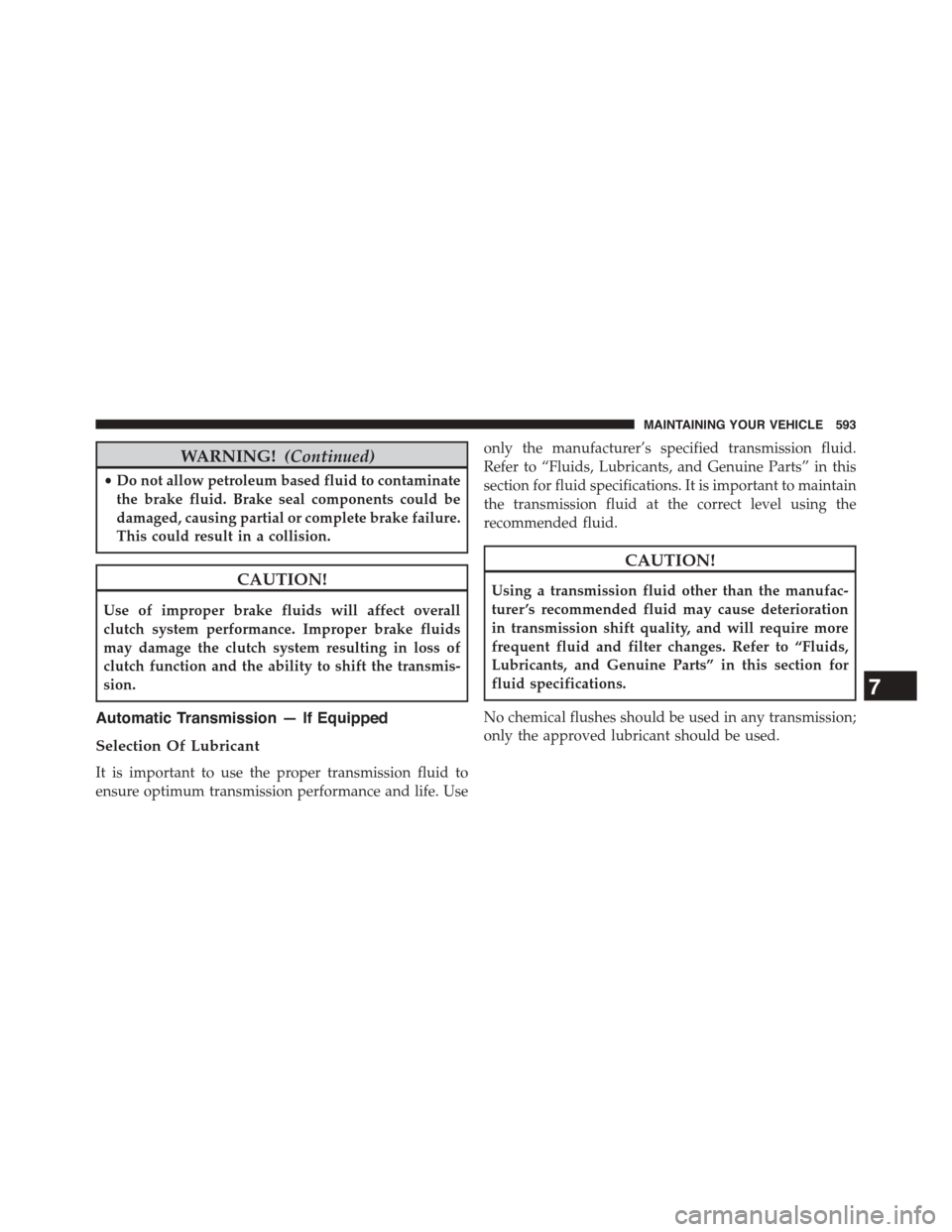
WARNING!(Continued)
•Do not allow petroleum based fluid to contaminate
the brake fluid. Brake seal components could be
damaged, causing partial or complete brake failure.
This could result in a collision.
CAUTION!
Use of improper brake fluids will affect overall
clutch system performance. Improper brake fluids
may damage the clutch system resulting in loss of
clutch function and the ability to shift the transmis-
sion.
Automatic Transmission — If Equipped
Selection Of Lubricant
It is important to use the proper transmission fluid to
ensure optimum transmission performance and life. Use
only the manufacturer’s specified transmission fluid.
Refer to “Fluids, Lubricants, and Genuine Parts” in this
section for fluid specifications. It is important to maintain
the transmission fluid at the correct level using the
recommended fluid.
CAUTION!
Using a transmission fluid other than the manufac-
turer ’s recommended fluid may cause deterioration
in transmission shift quality, and will require more
frequent fluid and filter changes. Refer to “Fluids,
Lubricants, and Genuine Parts” in this section for
fluid specifications.
No chemical flushes should be used in any transmission;
only the approved lubricant should be used.
7
MAINTAINING YOUR VEHICLE 593
Page 596 of 664
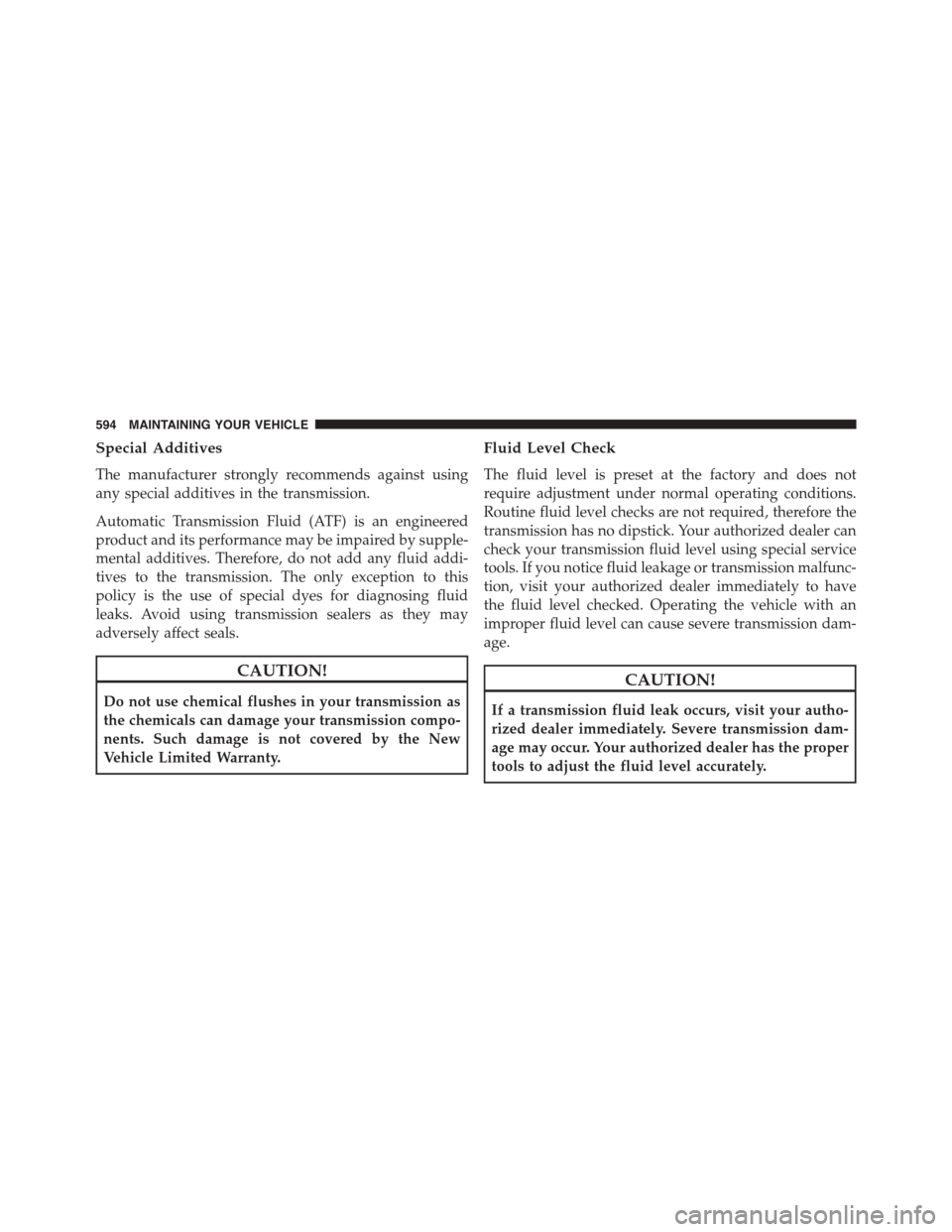
Special Additives
The manufacturer strongly recommends against using
any special additives in the transmission.
Automatic Transmission Fluid (ATF) is an engineered
product and its performance may be impaired by supple-
mental additives. Therefore, do not add any fluid addi-
tives to the transmission. The only exception to this
policy is the use of special dyes for diagnosing fluid
leaks. Avoid using transmission sealers as they may
adversely affect seals.
CAUTION!
Do not use chemical flushes in your transmission as
the chemicals can damage your transmission compo-
nents. Such damage is not covered by the New
Vehicle Limited Warranty.
Fluid Level Check
The fluid level is preset at the factory and does not
require adjustment under normal operating conditions.
Routine fluid level checks are not required, therefore the
transmission has no dipstick. Your authorized dealer can
check your transmission fluid level using special service
tools. If you notice fluid leakage or transmission malfunc-
tion, visit your authorized dealer immediately to have
the fluid level checked. Operating the vehicle with an
improper fluid level can cause severe transmission dam-
age.
CAUTION!
If a transmission fluid leak occurs, visit your autho-
rized dealer immediately. Severe transmission dam-
age may occur. Your authorized dealer has the proper
tools to adjust the fluid level accurately.
594 MAINTAINING YOUR VEHICLE
Page 621 of 664
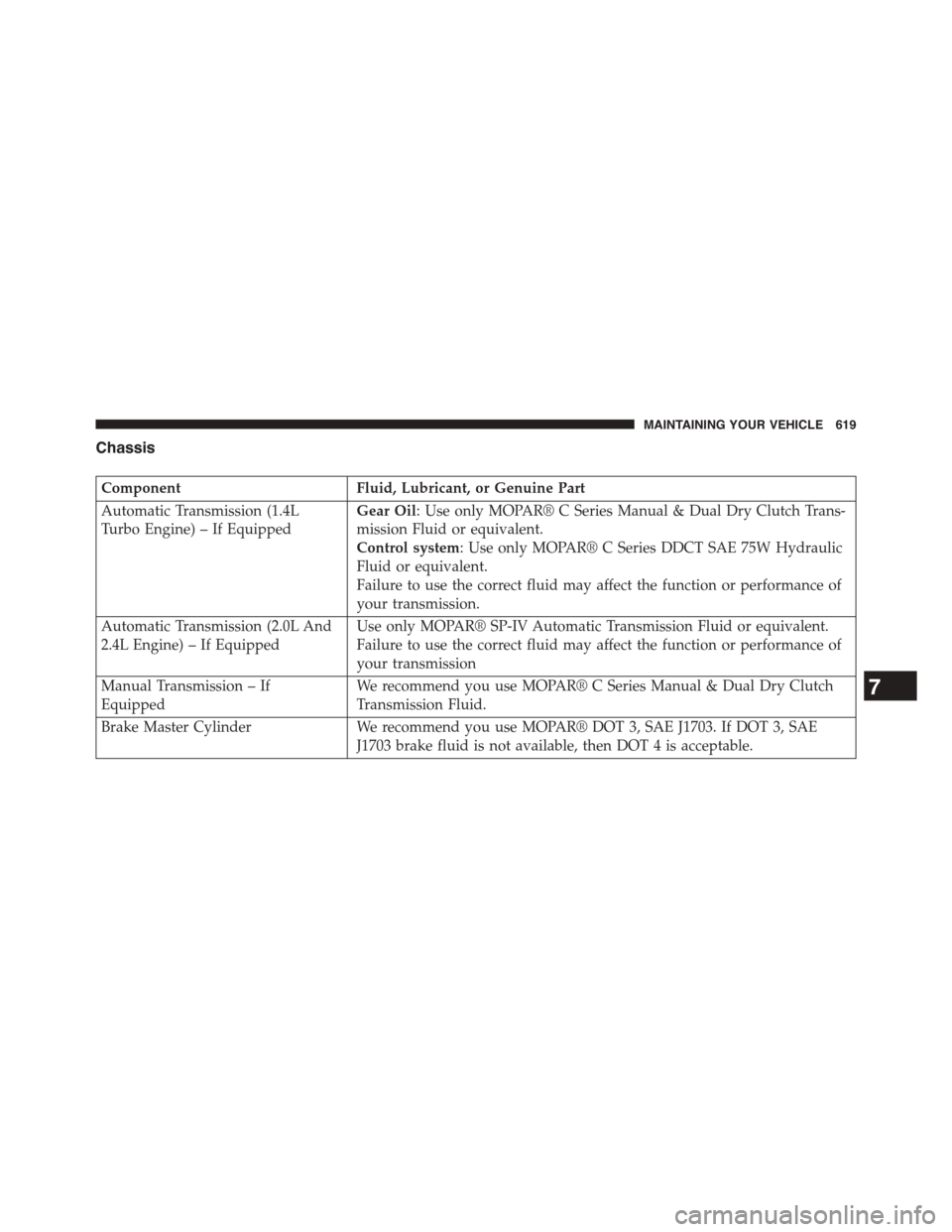
Chassis
ComponentFluid, Lubricant, or Genuine Part
Automatic Transmission (1.4L
Turbo Engine) – If Equipped
Gear Oil: Use only MOPAR® C Series Manual & Dual Dry Clutch Trans-
mission Fluid or equivalent.
Control system: Use only MOPAR® C Series DDCT SAE 75W Hydraulic
Fluid or equivalent.
Failure to use the correct fluid may affect the function or performance of
your transmission.
Automatic Transmission (2.0L And
2.4L Engine) – If Equipped
Use only MOPAR® SP-IV Automatic Transmission Fluid or equivalent.
Failure to use the correct fluid may affect the function or performance of
your transmission
Manual Transmission – If
Equipped
We recommend you use MOPAR® C Series Manual & Dual Dry Clutch
Transmission Fluid.
Brake Master CylinderWe recommend you use MOPAR® DOT 3, SAE J1703. If DOT 3, SAE
J1703 brake fluid is not available, then DOT 4 is acceptable.
7
MAINTAINING YOUR VEHICLE 619
Page 627 of 664
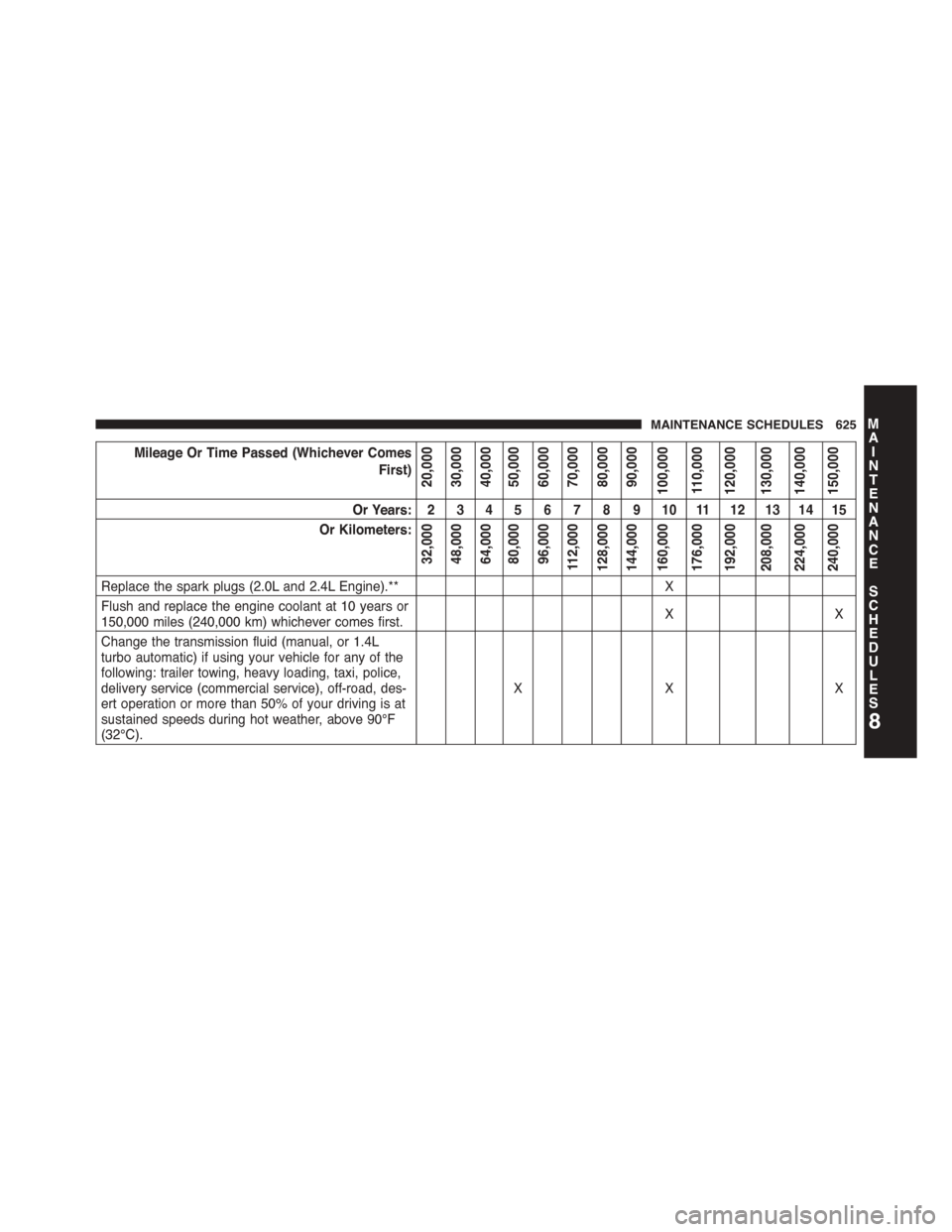
Mileage Or Time Passed (Whichever Comes
First)20,00030,00040,00050,00060,00070,00080,00090,000100,000110,000120,000130,000140,000150,000
Or Years: 2 3 4 5 6 7 8 9 10 11 12 13 14 15
Or Kilometers:
32,00048,00064,00080,00096,000112,000128,000144,000160,000176,000192,000208,000224,000240,000
Replace the spark plugs (2.0L and 2.4L Engine).**X
Flush and replace the engine coolant at 10 years or150,000 miles (240,000 km) whichever comes first.XX
Change the transmission fluid (manual, or 1.4Lturbo automatic) if using your vehicle for any of thefollowing: trailer towing, heavy loading, taxi, police,delivery service (commercial service), off-road, des-ert operation or more than 50% of your driving is atsustained speeds during hot weather, above 90°F(32°C).
XX X
8
MAINTENANCE
SCHEDULES
MAINTENANCE SCHEDULES 625